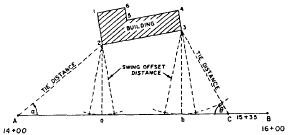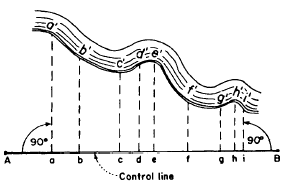|
Locating Points by Swing Offsets The SWING OFFSET is used for locating points
close to the control lines (fig.
13-21). Measurement of a swing
offset distance provides an
accurate determination of the perpendicular

Figure 13-21.-Swing offset method of locating points.

Figure 13-22.-Perpendicular offsets.
distance from the control line to the point being located.
The swing offset is somewhat similar to the
range tie (explained later), but as a rule, requires
no angle measurement. To determine the swing
offset distance, a chainman holds the zero mark
of the tape at a corner of the structure while another
chainman swings an arc with the graduated
end of the tape at the transit line AB. When
the shortest reading on the graduated end of
the tape is observed, the swing offset or perpendicular distance
to the control line is obtained at points
a or b. In addition, the horizontal distances between
the instrument stations (A and B) and the
swing offset points (a and b) maybe measured and
marked. A tie distance and angle a or f
may be measured from either
instrument station to the corner of
the structure to serve as a check.
Locating Points by Perpendicular Offsets
The method of PERPENDICULAR OFF-SETS from
a control line (fig. 13-22) is similar to
swing offsets. This method is more suitable than
the swing offset method for locating details of
irregular objects, such as stream banks and winding
roads. The control line is established close to
the irregular line to be located, and perpendicular offsets,
aa, bb, cc, and so on, are measured
to define the irregular shape. When the offset
distances are short, the 90 angles are usually
estimated; but when the distances are several
hundred feet long, the angles should be laid
off with an instrument. The distances to the offset
points from a to i are measured along the control
line.
|


|







